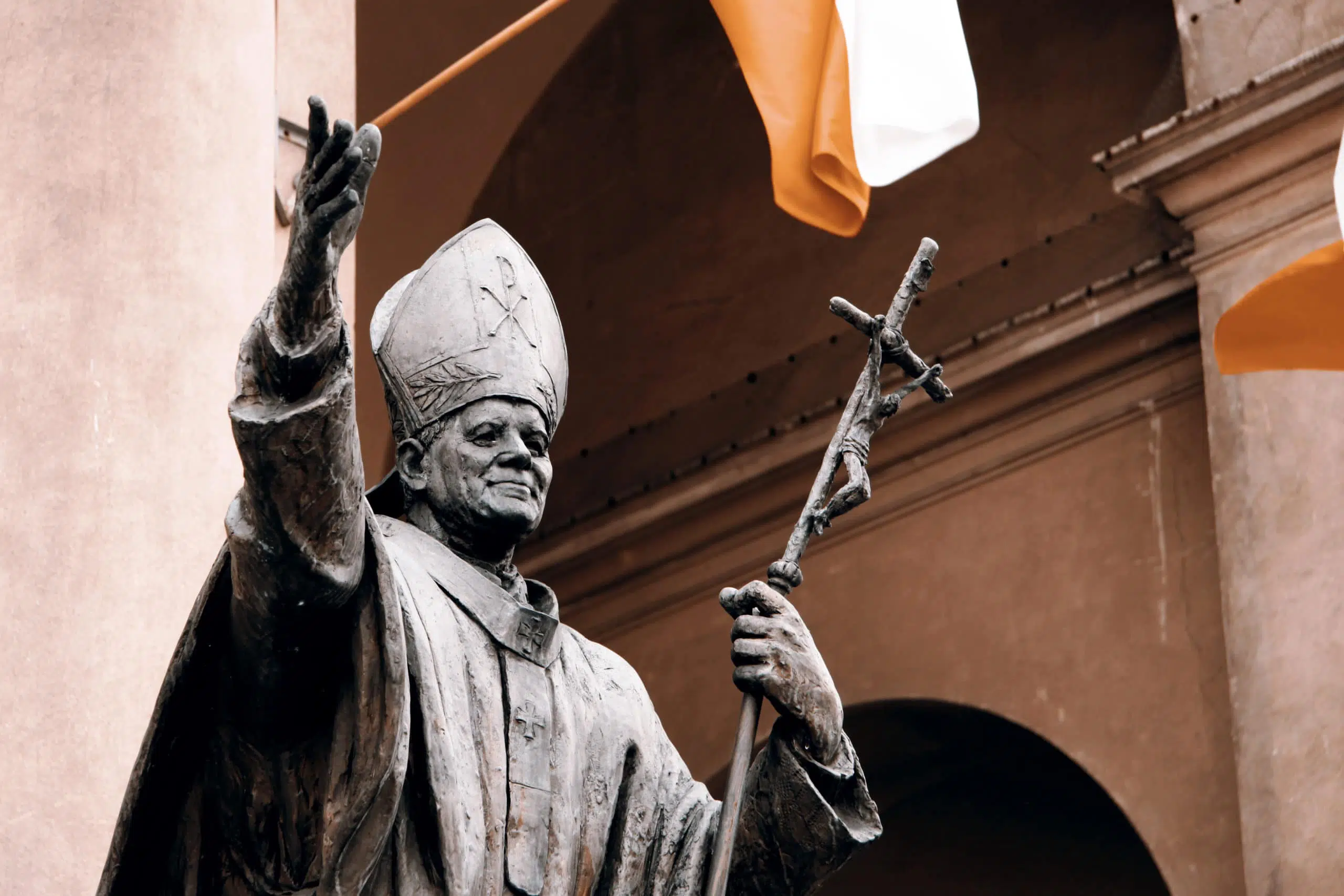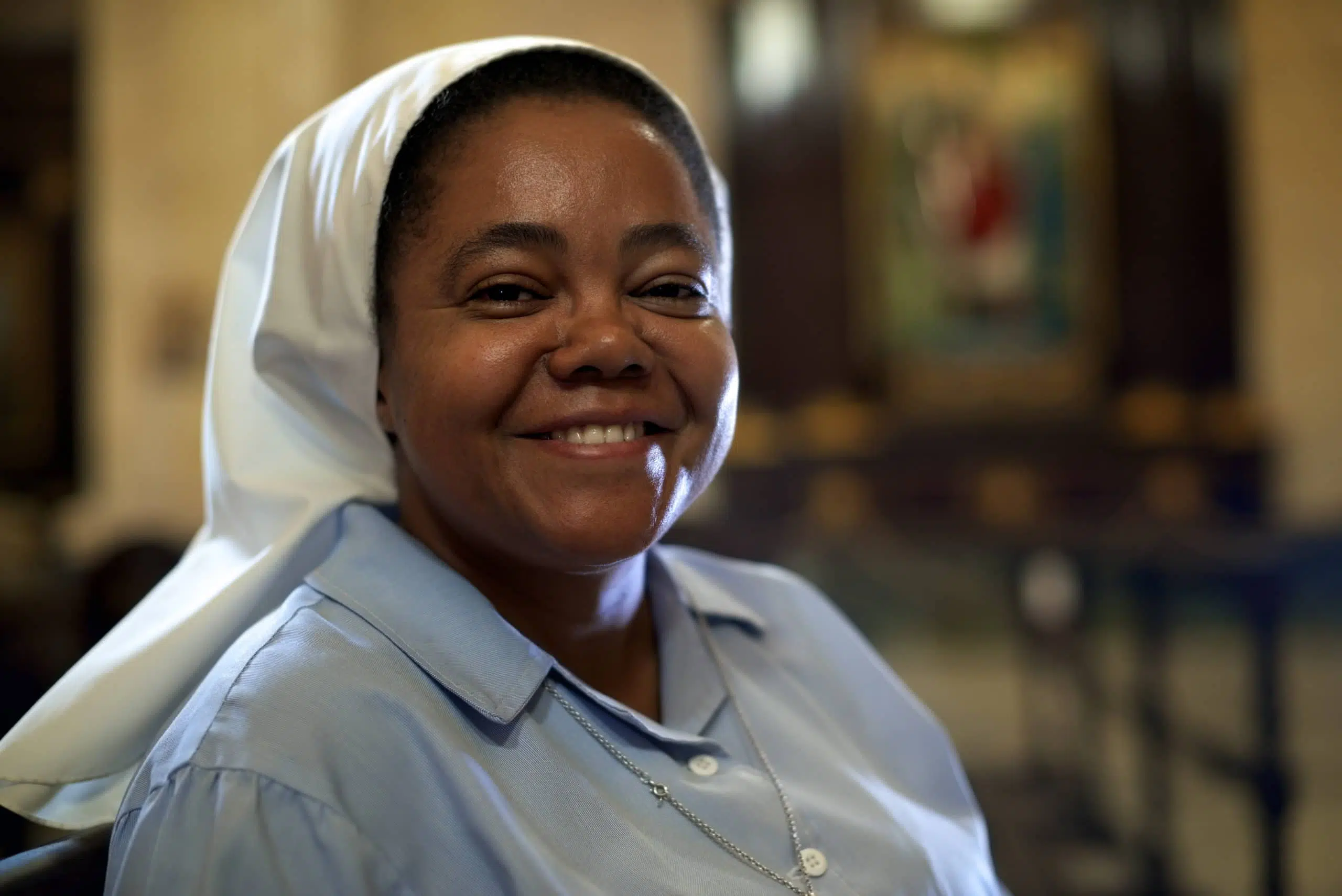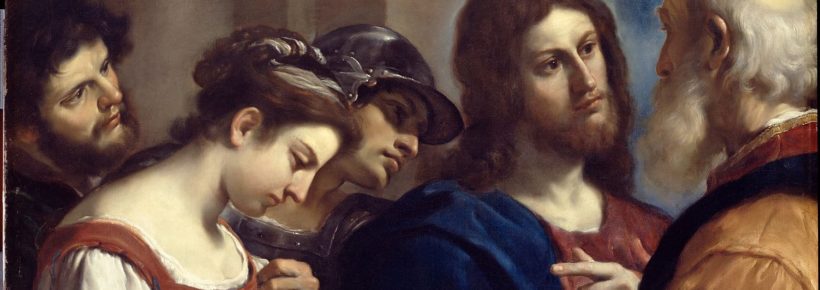Previous article in this series:
Next articles in this series:
- The Beginning: The Original Unity of Man and Woman
- Purity of Heart
- Resurrection of the Body
- Christian Virginity and Celibacy for the Kingdom of God
- The Sacrament of Marriage
- Love and Fertility
In our previous article we dealt with the topic of what the theology of the body is in the catechesis of St. John Paul II. In the present article we would like to approach the view the Holy Father had of human dignity. This topic is really the foundation of the previous one. In other words, the theology of the body has as its basis an “adequate Christian anthropology” (correct view of the human person). St. John Paul II developed this adequate Christian anthropology by reflecting on the Word of God, which is transmitted to us in both the written form of the Bible and the oral form of Sacred Tradition, the authoritative teachings of the Church through history (See the Catechism of the Catholic Church, nos. 96-100). Whenever the Pope made use of the human sciences and of human reason, he did so under the guidance of the Word of God.
In this article we will approach the following interrelated subtopics:
- The importance of human dignity to the theology of the body
- The personalistic anthropology of St. John Paul II
- Where he got his theology of the body from
- His teaching on love in general, and on conjugal love
- The conjugal meaning of the body in marriage
- The conjugal meaning of the body in Christ and His Church
1. Why is human dignity important for the theology of the body?
One of the main motives St. John Paul II had for writing his catechesis on the theology of the body was to defend human dignity. The dignity of the human person refers to his or her intrinsic and absolute value. A human possesses this value simply by being a person, and not by his race, religion, amount of money he or she has in the bank, position of power or lack thereof, or place of residence (inside or outside a mother’s womb).
This intrinsic and absolute value of the human person is an objective reality. That is, it exists independently of what people think or feel. Human dignity can never be lost by sickness, poverty, or any other adverse circumstance. It remains with us forever.
Following Church teaching, St. John Paul II also taught that the human person is a substantial (not accidental) unity of body and soul. The body is an intrinsic part of the human person. There cannot be a complete person if one of the two, the body or the soul, is missing. Going further, St. John Paul II taught that the human body expresses the person and his or her soul.
This view of the human body implies that human dignity applies to the body (see Catechism of the Catholic Church, nos. 364-365). Therefore, the body, too, must be respected, and not be used as an object of pleasure or utility. In other words, the human body has moral importance.
The Holy Father taught that the whole person, body and soul, must be respected. He emphasized that disrespect for the person’s dignity fails to view human beings as ends in themselves, and instead treats them as means.
St. John Paul II pointed out that disrespect of human dignity also takes place in human sexuality. In particular, men have the tendency, because of the effect of original sin, to view women as objects of sexual pleasure, and not as their beloved wives. St. John Paul II made this very clear in his catechesis on the theology of the body, especially in the second cycle, which treated the topic of “purity of heart” (catechesis 24-63).
2. What is the personalistic view of the human person?
St. John Paul II developed what has been called a personalistic view of the human person, which incorporates everything we have said so far about human dignity. But it emphasizes what has been called the relationship aspect. The human person is a relational being or a being-in-relation; his soul and his body have this intrinsic capacity to relate to others. The human person is not an isolated individual, but a social being.
The Holy Father taught that God had created men and women in His image and likeness, and that this meant that the human person was the only living being in material creation whom God had created to enter into an interpersonal relationship with Him and others. Only the human person stands “in front” of God. Only the human person reflects God in a personal-relational way.
Moreover, the Holy Father extended this relational dimension of the human person to his body. He taught that God had inscribed in the bodies of men and women the capacity to express love, calling this God-given capacity of the human person the conjugal meaning of the body. This conjugal meaning of the body is expressed sexually when man and woman unite themselves in the conjugal act within marriage.
3. Unity of Body and Soul
We are so used to a dualistic conception of the human person that we fail to understand that the human body also participates fully in the spiritual life. The Christian spiritual life does not consist in trying to “free” the soul from the body so that we can engage in “spiritual things.” In reality, the idea of the body as a “prison” of the soul is not Christian. It is an error that somehow crept into the Christian mindset by means of the influence of ancient pagan philosophers, like Plato and his followers (about IV BC).
The Holy Father rejected dualism outright, especially a form of dualism called Manicheism (about 200 AD), which tried to influence the early Church. St. John Paul II taught the very contrary: the spiritual life consists in integrating body and soul in our moral and spiritual conduct. To be clear, it is true that the soul is more important than the body, and that the body must subject itself to the soul. But rule of the soul over the body is not a despotic rule, but a loving rule in which the body readily obeys the soul and becomes the vehicle through which the soul, and indeed the whole person, lives the life God intended for the human person. And that life consists in loving God and loving our neighbor as ourselves.
It is true though that original sin caused the body to rebel against the soul and the soul against God. But, according to St. John Paul II and Church teaching, it was the soul’s fault that Adam and Eve fell into original sin (see Genesis 3). This is why we experience the selfishness of the body and of the soul in our lives. This is why we must discipline ourselves through prayer and some form of fasting to cooperate with God’s grace and put into practice authentic love. We need, as St. Paul puts it, “to live in the Spirit.” This means that our whole person, body and soul, is subject to God. By contrast, to live in the flesh is when the whole person, body and soul, is not subject to God and lives a life of selfishness, contrary to God (see Galatians 5:16-25).
So, you can see that the Holy Father’s conception of the human person is very beautiful and at the same time very realistic in its recognition of evil in our lives and in our world. But he is optimistic in our battle against our sinful desires, which come from both the body and the soul.
His optimism resides in the fact that God’s grace is infinitely more powerful than our sinful desires, the world’s anti-values, and the devil himself. That is why throughout his pontificate he repeated his famous call: “Be not afraid!” (See Romans 8:1-4; John 16:33; 1 John 4:4; John 12:31.)
4. Where did St. John Paul II get his “theology of the body?”
St. John Paul II got his theology of the body from the Incarnation! As St. John the Apostle said: “And the Word became flesh and dwelt among us” (John 1:14). The Incarnation means that the Son of God, the Second Person of the Holy Trinity, the Eternal Word of the Father, assumed a human body and a human soul, and thus became man (see CCC, nos. 479-483). In his catechesis, no. 23, the Pope comments on this passage: “The theology of the body has entered through the main door.” Indeed, the body of Christ is the most palpable way in which God has revealed Himself to us.
But that is not all. Following St. Paul, the Holy Father emphasized that the Church is the body of Christ. Each one of us is part of that body, and Christ is the Head. Based on Ephesians 5:21-33, the Pope also taught that Christian marriage is an efficacious image of Christ’s love for His Bride the Church. “Efficacious” here means that Christian marriage makes present the love and unity between Christ and His Church. This love is open to spiritual life because through Baptism Christ in spiritual union with His Church brings about new adopted sons and daughters of God (see CCC 1265).
Jesus Christ sacrificed His body on the cross for His Church, and also for all of humanity (see 1 John 2:2). But on the third day He resurrected; His body, by the power of God (Father, Son, and Holy Spirit) acquired a new and glorious life. By His death on the cross and His resurrection, Jesus redeemed us from our sins and gave us new life. If we are faithful to God, we too shall have a glorious body like Christ in the final resurrection of the dead (see Philippians 3:20-21).
Therefore, you can see that the whole Christian view of the human person is based on an appreciation for the body. In fact, the human body has the potential of transmitting what is invisible and spiritual, and plays an essential role in our human dignity. In his catechesis, no. 19, par. 4, St. John Paul II asserts that the human body “has been created to transfer into the visible reality of the world the mystery hidden from eternity in God, and thus to be a sign of it.” This mystery of God is nothing else than the fact that God designed a plan of salvation, and after much preparation through His People Israel, sent His Son to the world to save both Jews and Gentiles (non-Jews) and unite them into one Church, and eventually, at the end of times, unite and submit everything to God through Christ (see Galatians 3:23-28; and Ephesians 1:9-10).
5. What did John Paul II teach about the meaning of love, and, in particular, conjugal love?
St. John Paul II taught that true love is when the human person gives himself or herself to others in service. In short, love is self-gift. Love is also seeing oneself and others as ends in themselves and as gifts from God. Therefore, a more complete definition of authentic love is when we become ourselves a gift from God to others and at the same time when we welcome others into our lives as gifts from God. In the case of marriage, the spouses give and receive each other as gifts from God, especially in the conjugal act.
Outside of marriage, and especially those who have responded to God’s call of virginity and celibacy for the Kingdom of Heaven, live this love dynamic by giving themselves, body and soul, in service to others.
When people practice authentic love, the Hoy Father said that they are truly expressing the conjugal meaning of the body by means of a true language of the body. In other words, their bodily gestures – tending to the sick, feeding the poor, performing liturgical acts, etc. – truly express the conjugal meaning of the body. Otherwise, such language is a falsification, a counterfeit of true love, and contrary to human dignity.
Moreover, authentic love is by its very nature open to life, physically and spiritually. In the case of marriage, the conjugal act must always be open to life. This does not mean that from every conjugal act a new life must originate. It means that in every conjugal act the interconnection between the gift of self and the openness to life must be respected. St. John Paul II taught that openness to life and respect for the inseparable connection between love and life is also an intrinsic part of the conjugal meaning of the body. When spouses use contraception, sterilization, or abortion, they are falsifying the conjugal meaning of the body, and failing to respect their human dignity. Their language of the body is not a true language, but a false language, that betrays the true language of the body.
In fact, the recourse to contraception, sterilization, and abortion, is not only against procreation, but also against conjugal love since it deprives it of its intrinsic openness to life. An act of “love” deliberately made lifeless is also a loveless act, and a rejection of human dignity.
Similarly, when celibate persons “serve” other people with selfish ends in mind (vanity, for example) they are not communicating spiritual life. They are also falsifying the language of the body. They are not expressing the love-life connection which is intrinsic to the conjugal meaning of the body.
The Church teaches that “children are the supreme gift of marriage” (CCC 1652). Now, recall the Holy Father’s teaching about love consisting of becoming a gift to others and receiving others as a gift from God. Therefore, when parents realize that their children are the supreme gift from God, they are able to also see themselves as gifts from God to their children and to themselves. We see then in a new light how procreation and conjugal love find their unity in the conception of love as self-gift and seeing others as gifts from God. In this way, marriage participates in the power of God to create out love.
Let us also remember what we said earlier about the Sacrament of Marriage being an efficacious sign of the life-giving love between Christ and His Church. The true language of the body must follow the example set by Christ of a free and true love that brings about life to the fullest (see John 10:10).
It is evident, as we indicated above, that practicing true love is not easy. We all experience the tendency to be selfish within ourselves. But, when we are able, by the power of God’s grace, to love as we should, we are freeing ourselves of our selfish desires in order to become a gift to others. This is what John Paul II called “the freedom of the gift.” True freedom, according to him, is the capacity to control our selfish desires in order to be free to love others as Christ taught us. True freedom is love and truth.
6. How is the conjugal meaning of the body inscribed in every person’s body, even if they are not married?
God is a community of divine persons (Father, Son, and Holy Spirit) Who are constantly giving themselves and communicating divine life to each other. Moreover, when God created the universe, and specially the human person, He did so out of love, not out of any necessity. Therefore, His very act of creation is at the same time an act of love.
Now, every person has been created by God in His image and likeness. Therefore, every person has been created with this love-life dynamic in his very being, body and soul. Following Vatican II, John Paul II taught that the unity of human persons in community reflects in some way the loving unity of the divine persons. The most basic human community is the conjugal community, which then, through procreation becomes the family community, an image or icon of the Trinitarian Community.
The conjugal meaning of the body includes this love-life dynamic, which is to be lived out by every person, married or not. Of course, it is expressed differently, depending on your vocation, but in both cases, every person is to love authentically. This is an essential part of living with human dignity.
So, be not afraid! Let us rise and be on our way to treat others and ourselves as gifts from God!
Previous article in this series:
Next articles in this series:
Related Content
Adolfo is the Director of Education for Hispanic Outreach for Human Life International and of HLI's Hispanic outreach arm Vida Humana Internacional. He has a Masters in Theology from St. Vincent de Paul Regional (Major) Seminary and a License in Moral Theology from the Alphonsian Academy in Rome.
Adolfo has traveled frequently to VHI’s affiliates in Latin America to give talks, training sessions, and media interviews. He has authored and co-authored books, articles, reports, and a pro-life training course for Hispanics in the U.S. Adolfo has also participated in the production of two TV pro-life series in Spanish, which have been aired through EWTN en Español.

























Most insightful! Very amazing explanation of love! GODS relationship with humanity. True love in community. Now if we can apply this in areas of detail. How husbands treat wives. How fathers treat sons. Mothers daughters. Clergy to lay people etc etc.